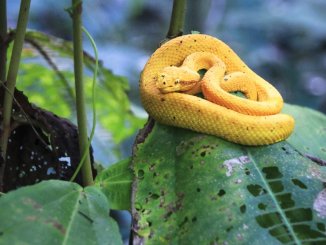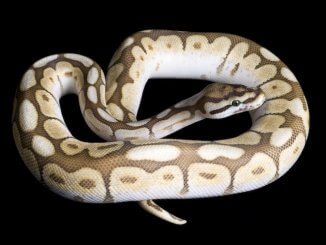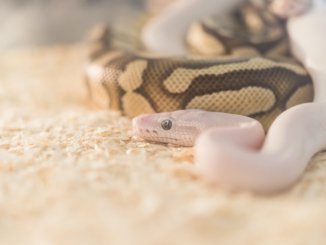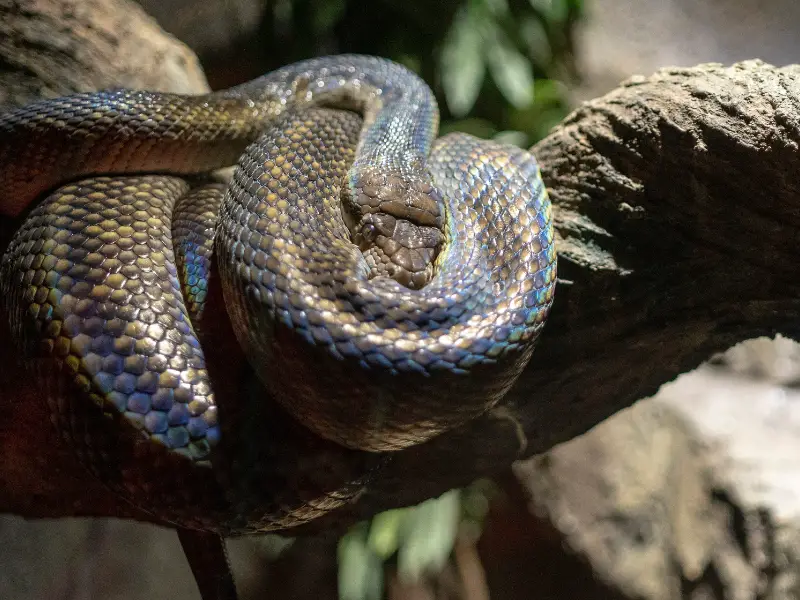
The scrub python (Simalia amethistina) is non-venomous and can make for a lovely exotic pet.
An important note before we begin: this article is about the amethystine python, commonly known as the scrub python. However, “scrub python” also sometimes refers to the Australian scrub python (Simalia kinghorni), a significantly larger snake that is much more difficult to source and care for.
If you’re searching for a scrub python, make sure you’re getting the right one and follow the appropriate care guidelines.
Owning one of these amazing creatures is not for the faint of heart, but if you’re a true fan of reptiles, it could be a great experience adopting one into your home.
Please continue reading to learn more about this wonderful pet and how to care for it!
Quick Fact
| Common name | Scrub python, amethystine python |
| Scientific name | Simalia amethistina |
| Adult size | 7'-13' |
| Tank size | Minimum 4' x 3' x 2' (L x W x H) for a snake less than 6ft. Length should be up to 6' for larger snakes. |
| Humidity & temperature | 55-60%; 80-85 °F (90 °F for basking area) |
| Care level | Experienced |
| Popular alternatives | Common boa, reticulated python |
What is a Scrub Python?
This species belongs to the Simalia genus, along with six other species listed below:
- Oenpelli Rock Python
- Halmahera Python
- Tanimbar Python
- Southern Moluccan Python
- Boelen’s Python
- Australian Scrub Python
Native to Papua New Guinea, Indonesia, and Australia, scrub pythons are one of the longest snakes in the world and can grow well over 10 feet long.
You will definitely need to consider this before committing to owning one of these amazing creatures because it’ll mean you’ll need to have ample room for it in your home.
Scrub Python Care Sheet
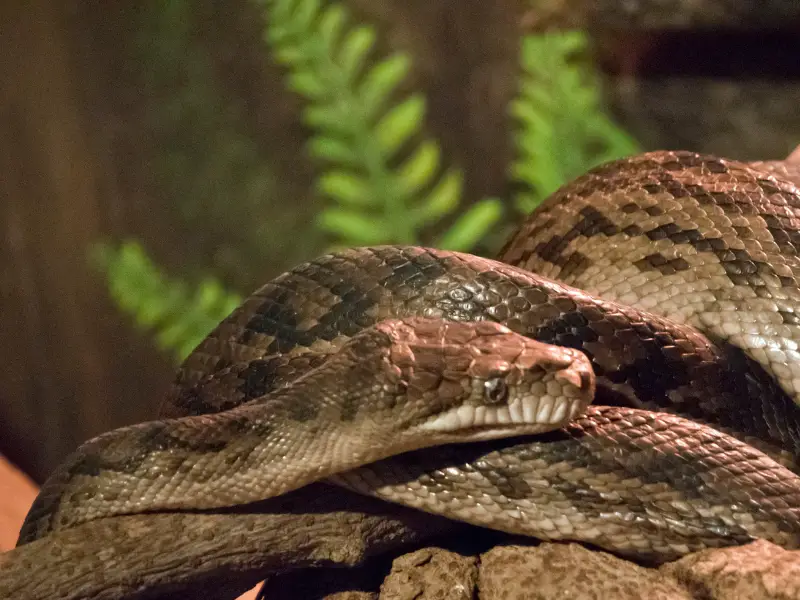
What Does a Scrub Python Eat?
When feeding your new pet snake, you should feed it small mammals, such as rats, mice, or possums. You could also feed it small birds or bats.
When you feed your reptile, please don’t give it live prey. Live prey may fight back and scratch and injure your snake, leading to other health complications.
In their natural habitats, larger specimens will catch and eat wallabies and cuscus.
How to Keep Your Scrub Python Healthy
One of the key ways to ensure your python is healthy is to purchase it from a reputable breeder and bring it to a licensed reptile veterinarian to check for early signs of disease or harmful parasites.
Never put more than one snake in a tank together because this could cause the python distress since they’re not social animals.
Tank Size
You also want to ensure that you purchase a suitable tank for your reptile friend that is created specifically to house it. The tank should be at least two-thirds the snake’s body length to be on the safer side – 6′ is generally a good length for an adult python.
Lighting and Heating
Usually, daytime temperatures of 80-85 °F will suffice. Avoid cooler temperatures because they harm your pet snake’s health.
You can keep the tank heated with special reptile heating pads or incandescent light bulbs in reflector hoods. Avoid any direct contact with these items and your snake.
You’ll also need to provide a basking area in the tank for your python. This area should be around 90 °F and have a branch-like structure for your pet snake to climb.
Substrate
A proper substrate is crucial to the snake’s health and well-being.
Choosing the right substrate could save you and your snake a lot of trouble.
The top items you should consider before purchasing substrate include each of the following:
- Good water retention to keep proper humidity levels
- Ability to repel mold and parasites
- Allows snake to burrow comfortably under it
- Easy to clean
- Inexpensive
- Availability (easy to find and purchase)
- Aesthetically pleasing
- Will not harm your pet if ingested
No matter which one of the options you decide to use for substrate, you must regularly clean out your tank to ensure it remains safe for them to live long, healthy lives.
Some great options for your pet scrub python would be:
- Bio-active soil
- Coconut fiber
- Coconut husks
- Cypress mulch
- Newspaper
- Butcher block paper
- Paper towels
You want to avoid using pine and cedar shavings because they could potentially release harmful oils and compounds into the air that are detrimental to your pet’s safety and health.
Additionally, sand should never be used for your snake’s bedding because it promotes the growth of mold, reduces humidity levels, irritates the respiratory tract, and may cause impactions due to clumping.
Scrub Python Behavior
Like most snakes, scrub pythons are not social animals. They prefer to be in their own space.
It is not recommended that you put one in a tank with another snake or animal if you want them to feel the most comfortable.
They can be up in trees but, as adults, tend to prefer being on the ground. Still, it’s a good idea for you to provide a branch-like object they can climb onto to make them feel more at home in their tank.
Usually, these reptiles are not especially aggressive and will not attack unless they feel threatened.
However, these snakes could pose a risk to small children and animals, so it’s best not to have any children or pets around one.
They’re more active at night, so don’t expect them to do much during the day.
Appearance
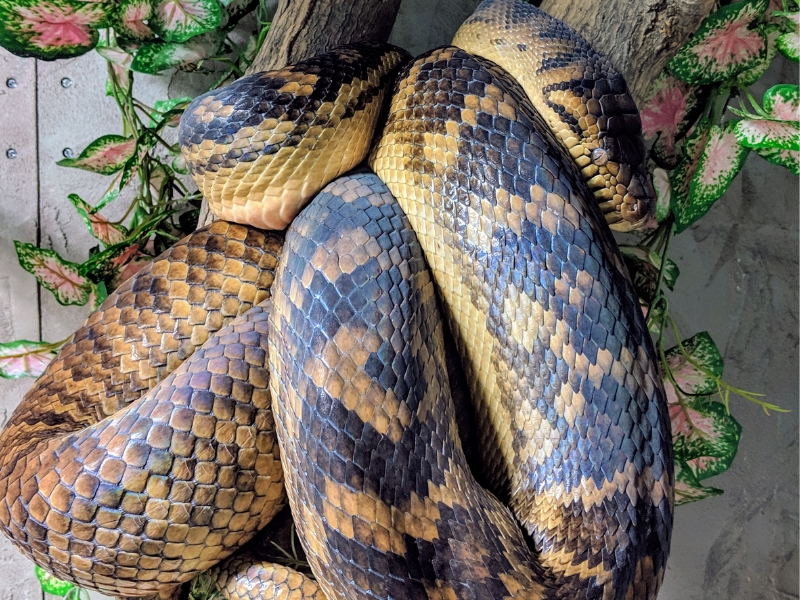
Scrub pythons are a sight to behold not only because of their size but also because of their amazing scales and color.
Their smooth scales vary in color but tend to have similar patterns. They typically have black or dark brown bands that form net-like patterns on their midsections.
Sometimes their scales can look iridescent, making for a mesmerizing appearance. The underbelly is usually a flat color.
Their head is triangular and typically smaller than their neck. They have light eyes (usually greenish-brown) and a flickering, forked tongue.
Size
As mentioned above, these reptiles can grow very large. Some have even claimed that they can reach over 20 feet in length (although this is rare).
Most of the time, the males are smaller/slimmer than the females but can still grow very large. On average, a male tends to reach 11- 24 lbs, while a female tends to be around 33 lbs.
Colors
These snakes range in color from a light golden yellow to a muddy greenish-brown. They have a blackish-brown net-like pattern on their bodies. They also have a beautiful iridescent appearance that reflects light.
The underside of the snake is usually a creamy beige tone. These snakes can camouflage well in the wilderness.
Scrub Python Babies
In the wild, scrub pythons tend to mate from late July to September. During mating season, it’s not uncommon for males to engage in battles to breed with their female counterparts.
Once a female has mated with a male, she can produce five to twenty-one eggs. Eggs will incubate for around 80 days. The mother snake will coil around the eggs during this time to keep them warm.
The mother snake will very seldom leave her eggs alone. This is to protect them from potential predators and to keep them warm. She will even forgo meals to keep her eggs protected.
If the eggs drop too low in temperature, it could harm the embryos and lead to serious issues or death. Because of this, it’s vital for the mother to stay with her eggs at all times, using her body to keep them at the right temperature.
After the eggs hatch, the baby pythons are approximately 10–16 inches long. These baby snakes will eat insects, very small rodents, eggs, or other nutrients that will fit in their mouths. Once large enough, they will consume bigger prey to satisfy their growing appetites.
They won’t usually want to after their first skin shedding, which generally occurs 20–30 days after they hatch.
How Much Does a Scrub Python Cost?
The price for a scrub python varies from hundreds to thousands of dollars. The cost typically depends on the snake’s age, gender, color, length, and mating ability. If you do decide to purchase one, ensure you go to a reputable breeder with extensive knowledge about this reptile.
Never purchase from someone who is illegally breeding or selling snakes. Also, check your local laws to make sure that owning a scrub python is permitted and under what specific conditions.
For example, the state of New York does not permit individuals to own certain species of snakes, including scrub pythons.
Care Guide Summary
| Pros | Cons |
| Non-venomous | Extra heat and lighting required |
| Non-aggressive | Cannot be housed together |
| Adaptable to captivity | Cannot have small children or pets around it |
The scrub python could make a great pet for most reptile enthusiasts! If you don’t mind their size, they’re beautiful, majestic animals to witness.
Although they may require a few extra accommodations, they’re relatively easy to care for and nurture.
If you’re thinking about purchasing one for your home, be ready with a suitable tank with appropriate heating and lighting to keep it healthy.

